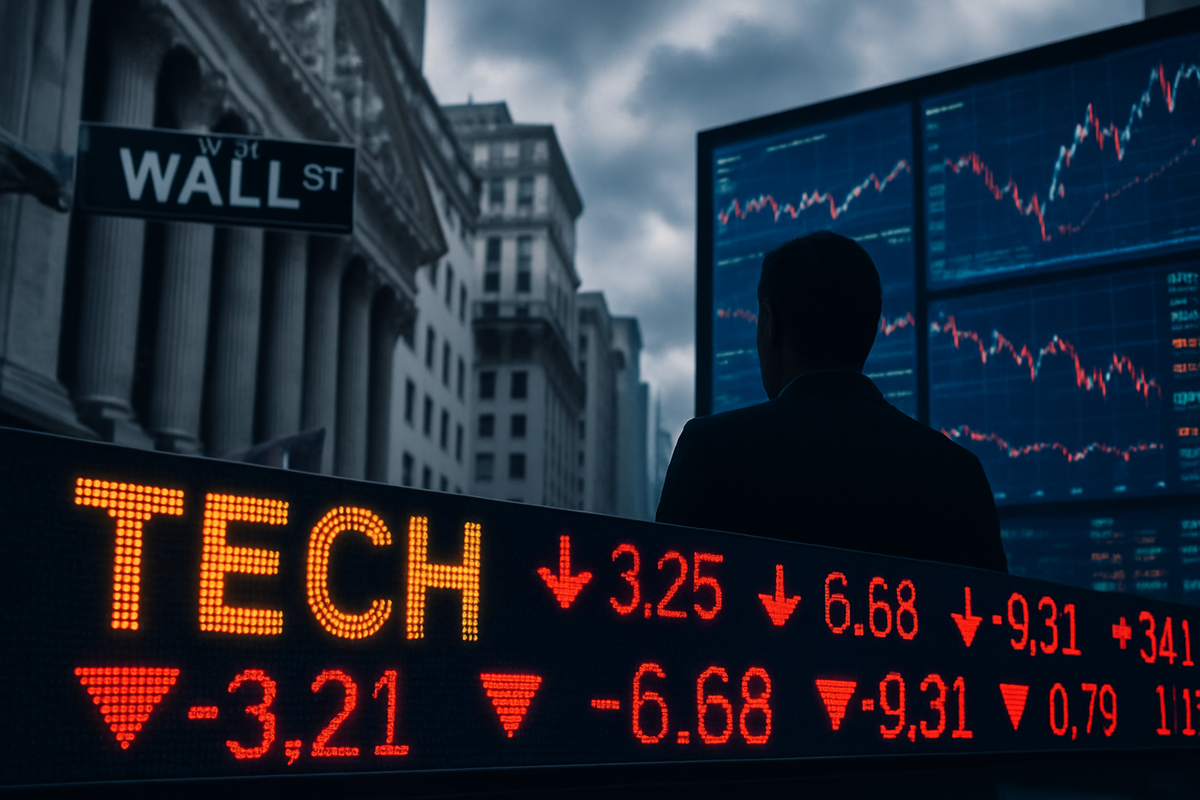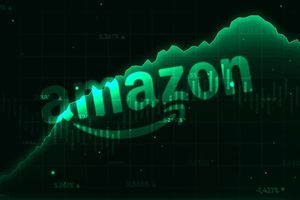
Wall Street experienced a day of mixed fortunes on Tuesday, as a significant sell-off in technology stocks dragged down major indices, while investors adopted a cautious "wait-and-see" approach ahead of Federal Reserve Chair Jerome Powell's highly anticipated speech at the Jackson Hole economic symposium. The S&P 500 and Nasdaq Composite both registered declines, marking a third consecutive day of losses for the broader market, even as the Dow Jones Industrial Average managed to eke out a marginal gain. This divergence underscores a prevailing uncertainty in the market, with the tech sector's recent rally facing a potential "breather" amidst concerns over future interest rate trajectories.
The immediate implication of this mixed performance is a palpable sense of anxiety among investors. The tech-heavy Nasdaq Composite's substantial drop, particularly among AI-related companies, signals a potential re-evaluation of growth stock valuations. With Powell's speech looming, market participants are keenly awaiting any signals regarding the Fed's stance on inflation and monetary policy, which could significantly influence market direction in the coming weeks and months.
Tech Sector Takes a Hit as Powell's Shadow Looms
Tuesday's trading session was largely defined by a notable downturn in the technology sector, particularly among companies that have been at the forefront of the artificial intelligence (AI) boom. The Nasdaq Composite (NASDAQ: IXIC) plummeted by 1.5%, or 1.27%, reflecting a broad-based retreat from high-growth tech names. This decline was a stark contrast to the Dow Jones Industrial Average (NYSEARCA: DIA), which managed a fractional gain of approximately 10 points (0.02%), showcasing a rotation towards more defensive or value-oriented stocks. The S&P 500 (NYSEARCA: SPY), a broader market indicator, also fell by 0.6%, or 0.53%, extending its losing streak.
The primary catalyst for this cautious sentiment and the tech sell-off was the impending speech by Federal Reserve Chair Jerome Powell at the annual Jackson Hole Symposium, scheduled for Friday. This gathering of central bankers is often a platform for significant policy insights, and investors are on edge, seeking clarity on the future path of interest rates. There's a prevailing concern that the Fed might be "behind the curve" on inflation, and any indication of prolonged higher interest rates could negatively impact growth stocks, which are more sensitive to borrowing costs. While the market has largely priced in at least a 25-basis-point interest rate cut at the Fed's upcoming September meeting, investors are looking for confirmation from Powell, though some strategists warn his remarks might not be as dovish as anticipated.
Key players in the tech sector experienced significant drops. Nvidia (NASDAQ: NVDA) fell around 3.5%, while Broadcom (NASDAQ: AVGO) also dropped about 3.5%. AMD (NASDAQ: AMD) saw an even steeper decline of 5.5%. Other tech giants like Meta Platforms (NASDAQ: META) and Tesla (NASDAQ: TSLA) both fell more than 2%, with Microsoft (NASDAQ: MSFT) and Amazon (NASDAQ: AMZN) also experiencing declines. Palantir (NYSE: PLTR) was particularly hard hit, plummeting over 9.5%. This widespread decline suggests that investors are taking profits after a strong rally in these stocks, or re-evaluating their positions in anticipation of potential shifts in monetary policy. The timeline leading up to this moment has been characterized by robust tech sector performance driven by AI enthusiasm, followed by increasing inflation concerns and the Fed's hawkish stance, culminating in this current period of uncertainty ahead of key economic signals.
Tech Titans Face Headwinds as Broader Market Holds Steady
The mixed performance on Wall Street on Tuesday created a clear divide between potential winners and losers. The most significant losers were undoubtedly the high-flying technology stocks, particularly those heavily invested in or benefiting from the artificial intelligence boom. Companies like Nvidia (NASDAQ: NVDA), AMD (NASDAQ: AMD), Broadcom (NASDAQ: AVGO), Meta Platforms (NASDAQ: META), Tesla (NASDAQ: TSLA), Microsoft (NASDAQ: MSFT), Amazon (NASDAQ: AMZN), and Palantir (NYSE: PLTR) all saw their share prices decline. This suggests that investors are either taking profits after a significant run-up or are becoming more risk-averse in anticipation of potentially higher-for-longer interest rates, which tend to disproportionately impact growth stocks whose valuations are often tied to future earnings potential.
The rationale behind these declines is multifaceted. Firstly, the sheer magnitude of the recent rally in AI-related stocks made them ripe for a "breather" or correction, as some analysts termed it. Investors might be re-evaluating whether current valuations are sustainable, especially if the economic outlook becomes less certain. Secondly, the looming speech by Federal Reserve Chair Jerome Powell is casting a long shadow. If Powell signals a more hawkish stance than the market currently expects – for instance, by indicating that interest rates might remain elevated for longer or that further rate hikes are not entirely off the table – it would increase the cost of capital for these growth companies, potentially dampening their future profitability and making their current valuations less attractive.
Conversely, the Dow Jones Industrial Average's (NYSEARCA: DIA) ability to close marginally higher suggests that sectors less sensitive to interest rate fluctuations or those considered "value" stocks might be emerging as relative winners. These could include established industrial companies, consumer staples, or utilities, which tend to offer more stable returns in uncertain economic environments. Investors might be rotating out of high-growth tech into these more defensive plays, seeking refuge from potential market volatility. While specific companies within the Dow were not highlighted as major gainers in the initial research, their collective performance indicates a shift in investor preference towards stability over aggressive growth in the immediate term.
Broader Implications: A Test for Tech's Dominance and Monetary Policy's Grip
Tuesday's market dynamics, characterized by a tech sector retreat amidst broader market caution, fit squarely into a larger narrative of economic uncertainty and the ongoing tug-of-war between inflation concerns and growth prospects. This event highlights a critical juncture where the exuberance surrounding technological advancements, particularly in AI, is being tempered by the realities of monetary policy and macroeconomic pressures. The significant decline in tech stocks, following a period of robust gains, suggests that the market is becoming increasingly discerning about valuations, especially as the cost of capital potentially rises. This could signal a broader industry trend where capital becomes more expensive, forcing companies to prioritize profitability and sustainable growth over aggressive expansion.
The ripple effects of such a shift could be profound. Competitors within the tech sector, particularly smaller, less established firms, might find it harder to secure funding or maintain their growth trajectories if investor sentiment remains cautious. Partners reliant on the tech giants for innovation or market reach could also face headwinds. Beyond the tech sphere, a sustained period of higher interest rates, hinted at by the market's anxiety over Powell's speech, could impact various industries by increasing borrowing costs for businesses and consumers alike, potentially slowing down investment and spending. Regulatory bodies will also be closely watching, as significant market volatility or shifts in sector dominance could prompt discussions around market stability and potential interventions, though no immediate regulatory implications are apparent from this single day's trading.
Historically, periods of high inflation and aggressive monetary tightening by central banks have often led to corrections in growth-oriented sectors. The current situation bears some resemblance to past cycles where speculative bubbles in certain industries were deflated by rising interest rates. While the underlying technological advancements, like AI, are fundamentally transformative, their market valuations are not immune to the broader economic environment. This event serves as a reminder that even the most promising sectors are subject to the overarching forces of monetary policy and investor sentiment, underscoring the interconnectedness of financial markets and the real economy.
What Comes Next: Navigating the Jackson Hole Aftermath and Beyond
The immediate future of the market hinges significantly on Federal Reserve Chair Jerome Powell's speech at the Jackson Hole Symposium later this week. Investors will be dissecting every word for clues regarding the Fed's stance on inflation, interest rates, and the overall economic outlook. A more hawkish tone, suggesting higher-for-longer rates or even the possibility of further hikes, could trigger continued volatility and a deeper correction in growth stocks. Conversely, a more dovish message, reinforcing expectations of rate cuts in the near future, could provide a much-needed boost to market sentiment and potentially reignite the tech rally.
In the short term, companies, particularly those in the technology sector, may need to consider strategic pivots. This could involve a greater focus on profitability and cash flow generation rather than solely on revenue growth, especially if access to cheap capital becomes constrained. For investors, this period presents both challenges and opportunities. While the immediate outlook might be volatile, a potential correction could create attractive entry points for long-term investors in fundamentally strong companies. Market opportunities may emerge in sectors that are less sensitive to interest rate fluctuations or those that stand to benefit from a potentially slowing economy, such as defensive stocks or value plays.
Looking further ahead, the market will be closely watching economic data, particularly inflation reports and employment figures, to gauge the effectiveness of the Fed's policies. Potential scenarios range from a "soft landing," where inflation is brought under control without triggering a severe recession, to a more challenging "hard landing" scenario. Companies will need to adapt their business models to navigate these potential outcomes, focusing on resilience and efficiency. The lasting impact of this period will depend on how effectively central banks manage inflation and how quickly the global economy can stabilize, shaping investment strategies and corporate decisions for months to come.
Conclusion: A Market at a Crossroads
Tuesday's mixed performance on Wall Street, characterized by a notable decline in technology stocks amidst broader market caution, serves as a critical reminder of the intricate dance between innovation, investor sentiment, and monetary policy. The sell-off in the tech sector, particularly among AI-related companies, highlights a market that is re-evaluating valuations and bracing for potential shifts in the economic landscape. This period of uncertainty underscores the significant influence of Federal Reserve policy on market dynamics, with all eyes now firmly fixed on Jerome Powell's upcoming speech at Jackson Hole.
Moving forward, investors should prioritize vigilance and adaptability. The market's direction in the coming weeks will largely be dictated by the Fed's signals regarding interest rates and inflation. While the tech sector has demonstrated remarkable resilience and innovation, its immediate future may be subject to greater volatility. Key takeaways from this event include the importance of diversified portfolios, a keen understanding of macroeconomic indicators, and the potential for a rotation from growth to value stocks in an environment of rising interest rates.
What investors should watch for in the coming months includes not only the Fed's actions but also corporate earnings reports, which will provide insights into how companies are navigating the current economic climate. The ability of businesses to maintain profitability and adapt to changing market conditions will be paramount. Ultimately, this period represents a crossroads for the market, where the path forward will be shaped by the interplay of monetary policy, corporate performance, and evolving investor confidence.





